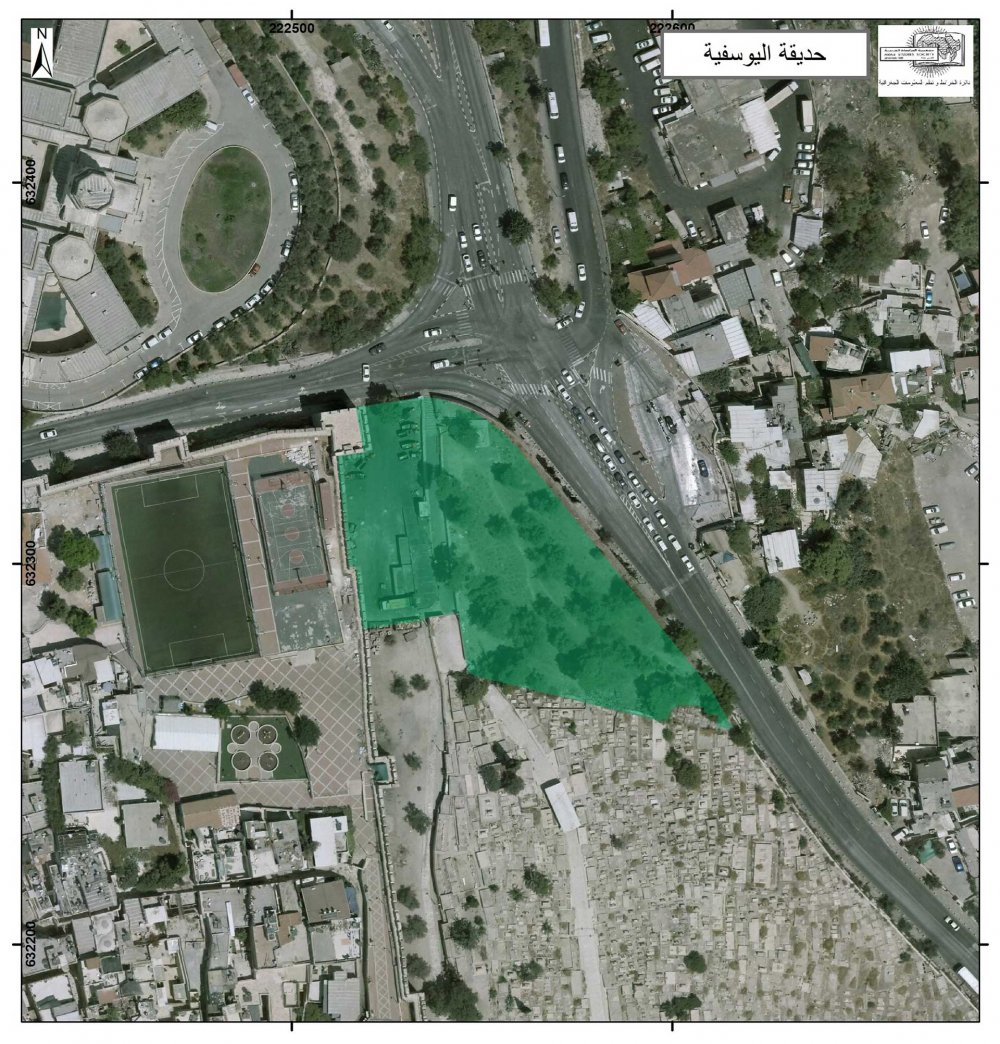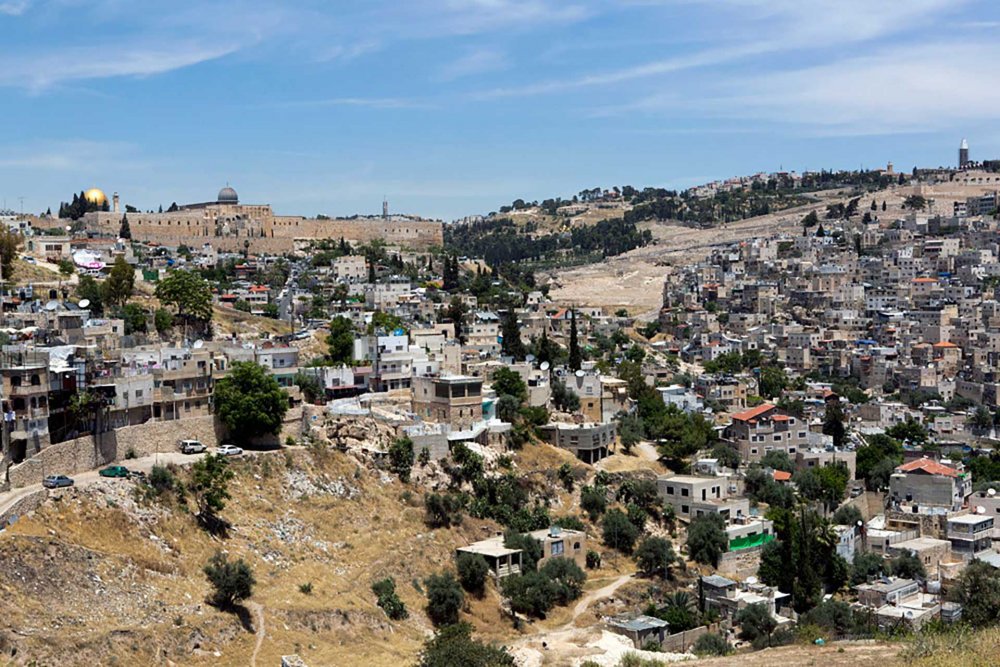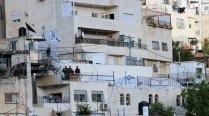Rows of cars are packed like sardines along the Old City walls of Jerusalem, with cars still lining up to squeeze into spaces within an inch of each other. What was once used as a parking lot sandwiched between the northeastern side of the Old City walls and the al-Yusufiyya cemetery looks like an earthquake hit it. The asphalt is cracked and torn apart after Israeli bulldozers dug up the pavement in February in preparation for a promenade.1

Credit:
Library of Congress, Prints and Photographs Division matpc [18903]
Israel Attempts to Seize Palestinian-Owned Parking Lot to Build Promenade
Snapshot
The Jerusalem Municipality is threatening to confiscate a small plot of Palestinian-owned land just outside the Old City walls that has served residents, especially worshippers wishing to pray at al-Aqsa Mosque, as a parking lot.
The area known as the Sheep Market or Friday Market covering approximately 4,484 dunums2 has been used by Old City visitors, merchants, and residents as a parking lot for the last few years.3 The Palestinian families of al-Uweisat, Atallah, and Hamad own the land but have rented it out to various governments for over a century, with Israel being the most recent lessee when it occupied East Jerusalem in 1967.
In the rental agreement between the landowners and Israel, the municipality said it would establish a park around Jerusalem’s Old City walls. In 1974, Israel declared this area and its environs as a national park known as Jerusalem Walls National Park. And in 1976, the Jerusalem Municipality approved local master plan number 9 (Plan AM/9), declaring Wadi Hilwa, the neighborhood surrounding the land, as a “special open area”—again banning construction of residential and public buildings there.4
“One of the methods of controlling land by the occupation authorities is to classify the lands and consider them green areas on which construction is prohibited,” Wissam Abdellatif, from the Arab Studies Society’s Maps and GIS department, explained to Jerusalem Story.5 “According to these plans, the Friday Market area was considered a green zone; the Jerusalem Municipality emptied the area as a first stage and took control of the place using the Public Interest Confiscation Law issued in 1943.”
In 2018, the Jerusalem Municipality stopped paying rent, alleging it owned the land, and in 2020 it began moving forward with a plan orchestrated by the Jerusalem Development Authority and the Israel Nature and Parks Authority (INPA) to build a promenade and park on the site—thereby initiating a six-year-long and still unresolved legal battle between the Palestinian landowners and the municipality.6
The landowners and the Muslim Waqf, which oversees the cemetery next to the lot, submitted objections to the promenade plan. For the owners, the land was their main source of income, and they saw it as part of their heritage; it had historic significance to them, and they did not want it being used in ways that were not specified in the lease. The municipality’s Local Planning and Building Committee rejected these claims on the basis that the area is part of the Jerusalem Walls National Park, so therefore only plans approved by the INPA are allowed.7
Dawood Atallah al-Uweisat, one of the landowners, told Jerusalem Story that the Uweisat family has a legal deed from the Ottoman Jerusalem Court going back at least 350 years. He asserted that ownership is claimed by those family members who remain in the country, and that the families did not try to evict the tenant when it broke the lease. The families proposed leasing the land to the municipality, which rejected the proposal.8 In 2021, the Israel Land Authority permitted the municipality to confiscate the land under the pretext the area serves the public’s interest. The landowners objected to this ruling in the district court; Dawood maintains that they “are determined to hold on to our land, and we will do what it takes to fight any confiscation order. The land will remain connected to those taking care of it.” Court hearings on their appeal have been repeatedly postponed, with the current date set for late April. “There have been so many games from the municipality to transfer the ownership of the land to the municipality,” Dawood told Jerusalem Story (see An Expert Unravels the Complexities of Land Ownership in East Jerusalem).
The municipality’s construction work at the property only occurred once in February, but since the area’s ownership remains contested in court, Dawood characterized the recent display as an intimidation tactic.
Jerusalem Story contacted the municipality and the Jerusalem Development Authority to ask about the legality of developing the land before a final solution is reached in court but received no response.
From Market to Garbage Dump to Parking Lot
More than a century ago, the area was used as a farmers’ market usually held on Fridays. When the Colonial British Mandate for Palestine ended in 1948 and the Jordanian government took over, the produce market was replaced by a livestock market instead, and it became known as the Sheep Market. When Israel occupied the land in June 1967, the Sheep Market shuttered, and while the rental contract outlined that the municipality would develop a park on the land, Dawood emphasized this wasn’t what materialized. Instead, Israel has used the area as an unauthorized landfill.
According to Dawood, the municipality placed a trash compactor on the family’s land in 1984 to condense the garbage after it was collected from the Old City. From there, a larger truck would transfer the waste to a landfill within a few days.
“Over time, the process of emptying the land from the garbage has become slower, and the use of the land has become as a dumpster more or less,” Dawood said. “When the garbage started piling up, it was very dirty and unpleasant for the eyes of those passing by as they were going to pray.”
In the last decade, residents of the nearby Palestinian neighborhood of Wadi Joz and the landowners have appealed to the municipality to address the sanitation issue—to no avail. In 2017, the Israeli government allocated NIS 6 million ($1.6 million) to the Ministry of Jerusalem and Heritage to remove the waste and devise a plan for tourism development in the area, culminating in the idea of a promenade.9 According to Dawood, however, the area is still being used as a dumpster.
Reaching an Agreement on the Common Good
Dawood emphasized when Israel occupied the land in 1967, the families were hesitant to rent to a government they didn’t know or understand, imposing an occupation whose duration was unknown.
“Those who were in charge of the municipality clearly stated that they have inherited everything from the Jordanian government, and according to the international law, they are entitled to all of the legal obligations that the Jordanian government was doing, of which one was renting this land,” Dawood explained.
Despite this, the families tried to implement conditions—like demanding JD 700 in rent—to prevent the municipality from renting the land. These efforts, though, didn’t deter Israel.
Dawood said the families aren’t against the municipality’s plans to turn the area into a public park, especially given this was one of the original terms of the rental agreement. Yet they want this to be something that benefits all, not only the Jewish public.
“We don’t want this project to change the demography or political situation of the Old City and Jerusalem [or] . . . to serve any extreme religious purposes,” Dawood said, noting the landowners’ request that a committee from the Old City’s Muslim Quarter lead renovation plans as they frequently use the lot.
The landowners have discussed the promenade proposal with the Muslim Quarter residents, who say they prefer a parking lot over a park.
“A parking lot that would not only serve residents of the Old City, but also serve merchants who have no place for the trucks to [deliver] goods,” Dawood said. “The municipality is not taking into consideration the real needs of the residents who are closer to that location.”
This sentiment is echoed by Muntaser Idkedek, who heads the Burj al-Luqluq Social Center Society in the Old City and used the parking lot before the municipality ripped it apart.
“It was very helpful, it was a great location to park in if you want to go to pray in the Old City. I don’t know why they [stopped allowing it to be used that way]; they just reduced the number of parking places for the Old City. If it’s something that’s supporting the people, we need to keep it to help the people living in the communities,” Muntaser told Jerusalem Story.10
“The work of the municipality is to support the people,” Muntaser added. “And this is telling us always, how is the occupation thinking? This is occupation. There’s something helping the [Palestinian] people living in the area, and they’re trying to stop it.”
According to the archaeological rights organization Emek Shaveh, Palestinians fear the promenade plan will lead to settler groups, like Elad, expropriating the land and displacing Palestinians, which has already happened in other parts of the Jerusalem Walls National Park.11
Confiscating the Sheep Market land appears as part of a plan to link future settlements and encircle the Old City in settler tourism endeavors.
“This control aims to connect the area to the settlement outpost that was planned in the future in the Burj al-Luqluq area,” Wissam told Jerusalem Story.
In addition to the Sheep Market promenade plan, another settlement is planned for the nearby Burj al-Luqluq area comprising 22 housing units. To the east of the Sheep Market, another plan is in the works to demolish the al-Hisba market and build a tourist complex—featuring 200 rooms and halls—over the ruins.
While the plans are at various stages, the goal remains the same: to seize Palestinian land under the guise of creating a communal green space and develop it in ways that serve majority Jewish interests at the expense of the Palestinians who live there.
Notes
“East Jerusalem on the Eve of Ramadan and Municipal Elections,” Peace Now, February 22, 2024.
“Sheep Market, Jerusalem” [in Hebrew], 2022, Jerusalem Municipality.
Wissam Abdellatif, WhatsApp message to the author, April 25, 2024.
“Jerusalem Walls National Park,” B’Tselem, September 16, 2014, updated July 28, 2015.
Wissam Abdellatif, written comments to the author, April 24, 2024. All subsequent quotes from Abdellatif are from these comments.
“East Jerusalem: Death and Redemption in Jerusalem’s Historic Basin,” Emek Shaveh, June 15, 2023; Nir Hasson, “Jerusalem Board Approves Old City Promenade on Remains of Muslim Cemetery,” Haaretz, March 1, 2022.
“Death and Redemption.”
Dawood al-Uweisat, interview by the author, March 29, 2024. All subsequent quotes from al-Uweisat are from this interview.
“Death and Redemption.”
Muntaser Idkedek, interview by the author, April 4, 2024. All subsequent quotes from Idkedek are from this interview.
“Death and Redemption.”





